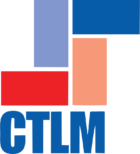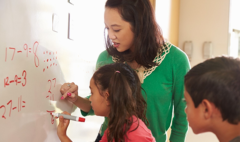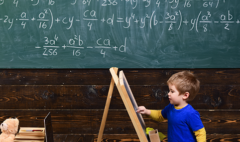Reversing the decline in SAT math scores
March 11, 2021 2021-03-31 18:45Reversing the decline in SAT math scores
Reversing the decline in SAT math scores
Reversing the Decline in SAT Math Scores
To reverse the decline in math scores and engender in our children an interest and expertise in mathematics, educators need to pay attention to teaching methods. In countries where students do exceptionally well and in U.S. schools where students excel, there are three key attributes:
- Each grade has a focus. In other words, there are non-negotiable skills that students master in that grade;
- Everyone in the school system understands and practices the common definition of knowing;
- The key concepts and procedures are taught using efficient and elegant models—methods that are generalizable and develop mathematical ways of thinking in our students.
The Common Core State Standards in Mathematics (CCSS-M, 2010) have brought the nation’s attention to these three aspects of mathematics learning. CCSS-M stands on three legs:
- Every grade has a focus on a few key concepts to be taught and learned;
- Those topics must be taught with rigor—understanding, fluency, and applicability (in other words, with mastery);
- There should be coherence in teaching these topics—a teacher should know the trajectory of the development of the concept or procedure—where it begins and how it develops in different grades.
With effective methods of teaching, we will achieve the intended objectives of the CCSS-M: higher achievement and interest in mathematics on the part of our students and the general public.
One of the important components of effective teaching is achieving mastery and that is dependent on practice of the material taught—language, concepts, procedures, skills. In the previous post (SAT Math Scores Decline in 2015), I emphasized the importance of practice. In this post, I want to focus on how to do that practice.
To benefit from practice, there is need to dissect the main skill into sub-skills, constantly evaluating their status, and practicing them in isolation and in combination.
Take the long division algorithm, for example, which involves several sub skills—estimation (what do I expect as the answer?), multiplication tables (with fluency and understanding—a fact is recalled in less than two seconds or less), place value (in order to know the size of the partial quotient), spatial skills (organizing and aligning numbers), subtraction (with fluency and understanding—using decomposition/recomposition), and sequencing (following the order and sequence of actions involved in the procedure).
Step One
Break Down the Skill: Create a Graphic Organizer
First, write the skill to be improved in a central bubble. Make branches to recognize each sub-skill necessary for performing the broader skill well. For example, the long division algorithm is in the center and multiplication tables, place value, subtraction, spatial orientation/space organization, etc. are the spokes from the central bubble. Similarly, when adding fractions, the addition of fractions is in the center and multiplication tables, divisibility rules, prime factorization, short division, concept of fraction, such as a fraction is equal to one when the numerator and denominator are equal, etc. are in the spokes.
The process continues (creating branches from branches) until the leaves of the branches are simple skills. Depending on the skill and the ability to articulate it, one may have anywhere from a dozen leaves to many more.
Step Two
Evaluate Learner Performance on Each Sub-Skill
Mark each leaf on the branch by its importance with either critical, important, or of minor importance. Assess each branch using a rating for performance as good, okay, or poor for each leaf. Evaluate each sub-skill for understanding, fluency and applicability.
Identify branches and leaves that have high importance but low proficiency. If a leaf is critical but the student is unsuccessful in it, that represents the best candidate for immediate improvement and practice. Identify the top three sub-skills that require your most urgent attention.
Step Three
Develop Practice Exercises to Improve Sub-Skills
Develop an exercise to practice using efficient strategies. Even short intervals of supervised practice, first alone and then with others, can be powerful, if the skill was specified clearly and the strategy used is efficient. Independent practice should take place when one is fluent under supervision.
Deliberate practice isn’t easy, which is why most people plateau at a level far below their potential. It is hard to do concentrated, uncomfortable practice on previous skills on top of the demands of the current grade level of work. The planning of and focusing on the components of practice is therefore important. Successful practice is a function of the nature of the content to be mastered, number of practice events, time of practice, nature of practice, the nature and frequency of feedback, etc.
There are two ways of practicing skills to reach a level of automaticity: block practice—repetitive drilling on the same task in one block of activity and variable practice or interleaving—to practice several skills in succession. Interleaving works better in all but the youngest learners because it seems to fit the mind’s natural capacity to detect patterns and recognize differences.
Interleaving practice is particularly useful when students practice a complex, multi-step skill or process such as long division, operations on fractions, or solving equations. If, for example, some aspect of the process is particularly troublesome for students, they might need to be given assignments that help them focus their practice on that one aspect only.
Achieving Mastery
Practice of a concept or skill begins with efficient note taking – an important academic skill students, particularly at the middle and high schools levels, need to develop to have higher achievement in mathematics. It includes how to take notes during teacher and student presentations and then how to summarize work and learning. Through note taking, the information transfers from the teacher to the student and from the student to the teacher. Because the development of note taking skills cannot be left to chance, the teacher has to teach these skills explicitly.
Practice allows students to achieve automaticity of basic skills—the fast, accurate, and effortless processing of content information—which frees the working memory for more complex and higher order thinking and fosters the development of creative aspects of problem solving. With automaticity with understanding, the transfer—the ability to use skills learned in solving one class of problems to solving other problems—a vital part of mathematics learning is possible. Without understanding, students’ ability to make links between related domains is limited. When there is significant overlap in content areas, practice in one leaves an impact on the other. For example, in middle school, work on fractions, decimals, ratio, proportion, and percent should be integrated and practice exercises should include problems from all of them. If students practice pulling general concepts out of a collection of specific examples and give multiple different examples for the general idea, then their ability to transfer skills and procedures increases.
Individual and Small Group Practice
On the average, how many problems does an average student need to practice to achieve a level of competence? And when should students practice? To reach a fair level of competence in a skill takes a great deal of practice. Not until students have practiced a skill upwards of 12 times that they reach an 80 percent competency level. Of course, there will be variations depending on the nature of the skill being practiced and learner differences. Also, when a high level of mastery is reached, the increase in competence is less after each practice. This means the practice should not be in one big practice session but over a period of time. For this reason, part of each day must be devoted to practicing previous material—tool building.
The first four practice sessions result in a level of competence that is almost 50 percent of complete mastery. The next four sessions, however, account for only an approximate 14 percent increase. Therefore, learning new content does not happen quickly. It requires practice spread out over time. The results of this practice will be increments in learning that start out rather large but gradually get smaller and smaller as students fine-tune their knowledge and skill. Only after a great deal of practice, can students perform a skill with speed and accuracy.
Once an acceptable level of understanding and performance is evident, students should work individually because they can be expected to be reasonably close to high performance. They should practice problems and exercises to consolidate their knowledge and gain proficiency. Each student should attempt the same or similar sets of problems, and the differentiation should be achieved through the level of assistance offered for successful completion and the time it takes in achieving this.
Individual work may take multiple forms. For example, it may be conducted in silence to allow for quiet practice, contemplation, and self-assessment. The teacher can circulate to check that the students complete the work accurately, to diagnose problems, and to give strategies for remediation and improvements. During this time, the teacher monitors students’ work – how they are solving the problems, but also collects informal records on the students’ progress and decides which students require assistance and who will be asked to present solutions in the summarizing phase of the lesson.
Explicit instruction for students with and without mathematical difficulties has shown consistently positive effects on performance with both word problems and computation. By the term explicit instruction, I mean that teachers provide clear models for language, concepts, and procedures for solving a problem type using an array of examples. It also includes extensive practice in the use of newly learned strategies and skills and opportunities to think aloud (i.e., talk through the decisions students make, the strategies they plan and use, and the steps they take), and extensive feedback, in the use of strategies and relating strategies to outcomes.
Not all of students’ mathematics instruction should be delivered in an explicit fashion. However, struggling students should receive a significant part of their mathematics instruction explicitly. Some time should be dedicated to supervised practicing in automatizing foundational arithmetic skills and conceptual knowledge necessary for learning the mathematics at their grade level. While practicing, students should be helped to adapt and change strategies according to the context.
Understanding and Automaticity
To retain a skill and use it efficiently at will requires its mastery—understanding and automaticity. To master and use a skill or procedure, one needs to have either conceptual understanding so that one can reconstruct it as needed or automatized it. To be proficient in the use of a skill one should have both understanding and automaticity.
Conceptual understanding assures accuracy in its usage. However, accuracy alone is not enough. For instance, reconstructing a skill each time it is needed is inefficient. One can also automatize a skill or procedure by over learning it. However, if the conditions under which the procedure is to be applied are modified even minimally, one may not be able to apply the procedure. Automaticity is achieved more easily and faster if there is a clear understanding of the concept underlying the skill, first. Then, practice is more productive.
In the initial learning phase of a skill, concept, or procedure, the teacher needs to focus on identifying its salient attributes and help students to understand it by modeling, demonstrating, and breaking it down into its components (task analysis). The aim is to accommodate and assimilate it within existing schemas or if necessary, expand and reorganize them in order to integrate the new concept with old concepts and procedures. The students must adopt and “shape” these new schemas. This learning phase is a “shaping process.”
During the shaping process, the teacher focuses on learners’ attention on their conceptual understanding of the concepts and skills. Without this shaping, they are liable to develop misconceptions or use the procedure in ineffective ways.
The goal of practice is to master the skill—acquire both speed and accuracy, but the goal of the shaping phase is to gain accuracy. It is important to deal with only a few examples during the shaping phase of learning a new skill or process.
The shaping phase is not the time to press students to perform a skill with significant speed. Ineffective teachers tend to prematurely engage students in a heavy practice schedule and rush them through multiple examples. In contrast, effective teachers attend to the needs of the shaping process by slowly walking students through only a few examples.
Technology Assisted Drill and Practice
Tutorials using Computer Assisted Instruction (CAI) programs that are well designed and implemented can have a positive impact on mathematics performance, particularly at the middle and high school levels. Still, educators should critically inspect individual software packages and the studies that evaluate them. They should assess if the software has been indeed increased the learning in the specific domain and with students who are similar to those who will use the software.
Charting Accuracy and Speed
Skills should be learned to the level that students can perform them quickly and accurately. To facilitate skill development, students should be encouraged to keep track of their speed and accuracy. This might be best accomplished if they can chart both. For example, I use addition and multiplication ladders to automatize arithmetic facts. As the student completes an individual ladder for a number, he/she records the completion time. Next time, the student tries to beat his/her time. When students can complete a ladder in 15 to 20 seconds without any error, at least three times, they have automatized that addition/multiplication table.
During the modeling phase, students can be given individual and collaborative targets in order to raise expectations and to keep the class working together. That is not to say that students are put under undue pressure, but that they are encouraged to take responsibility for making an effort and doing their very best. The constant monitoring provides the best form of diagnostic teaching and leaves the students little time for goofing off.
Tests as Aids in Mastery and Understanding
Tests have traditionally been used as a measure of learning. Properly used, tests can be and are themselves learning events. The retrieval processes triggered by tests enhance recall, sometimes to a much greater degree than do comparable opportunities to restudy the information. Restudying is better than testing in the short term, whereas an advantage for testing emerges at longer retention intervals. Testing also appears to have greater benefits for subsequent free-recall or cued-recall testing than it does for forms of testing that are less dependent on recall, such as tests of recognition or priming. Two factors that have been found to moderate the testing effect are final-test delay and final-test format:
- Later recall profits from having an earlier test (or tests) of to-be- remembered information versus not having a prior test, and
- later recall profits, under some conditions, more from having an earlier test (or tests) than it does from having an opportunity (or opportunities) to restudy the information in question.
From this perspective the test may have only one problem, but it calls for thinking and integration of knowledge. For example, rather than asking 20 multiplication facts, one can ask:
Problem 1: Make all the possible rectangles of area (a) 24, (b) 64, (c) 48 with whole number sides.
Problem 2: Write a six digit number between 400,000 and 500,000 that is divisible by 2, 3, 4, 5, 6, 8, 9, and 10.
Tests as Practice Aids
Tests tax a student’s fluency, recall/retrieval, and understanding. Tests provide training in retrieval in integrative ways. The testing situations add a level of desirable difficulty, recalling of various learning and problem-solving strategies used in the testing process enhance long-term memory. The more difficult the initial test, provided retrieval succeeds, the larger is the benefit of testing.
Restudying, on the other hand, involves much more fluent processing than taking a test and adds to fluency and a better subsequent memory.
The retrieval processes engaged by tests constitute practice for a criterion test later. The idea is that tests enhance memory on subsequent tests because they give learners the opportunity to engage in retrieval processes of the type that will be required on a later test. The benefits of practice tests increase as a function of their similarity to the final test.
Testing improves long-term memory relative to an equal amount of time spent restudying, even in the absence of feedback. However, testing is not always better than restudying, particularly when fluency and understanding are absent. Sometimes restudying is better, and sometimes the two conditions do not differ significantly.










